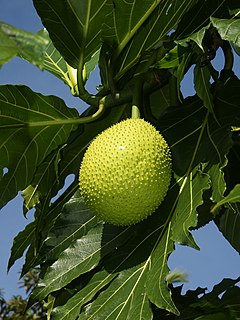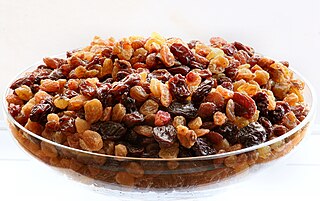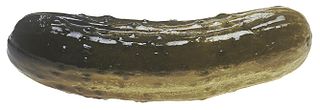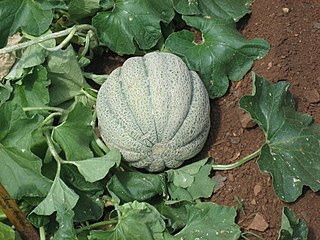Related Research Articles

A grape is a fruit, botanically a berry, of the deciduous woody vines of the flowering plant genus Vitis. Grapes are a non-climacteric type of fruit, generally occurring in clusters.

Breadfruit is a species of flowering tree in the mulberry and jackfruit family (Moraceae) believed to be a domesticated descendant of Artocarpus camansi originating in New Guinea, the Maluku Islands, and the Philippines. It was initially spread to Oceania via the Austronesian expansion. It was further spread to other tropical regions of the world during the Colonial Era. British and French navigators introduced a few Polynesian seedless varieties to Caribbean islands during the late 18th century. Today it is grown in some 90 countries throughout South and Southeast Asia, the Pacific Ocean, the Caribbean, Central America and Africa. Its name is derived from the texture of the moderately ripe fruit when cooked, similar to freshly baked bread and having a potato-like flavor.

Tzatziki, also known as tarator or cacık, is a dip, soup, or sauce found in the cuisines of Southeast Europe and the Middle East. It is made of salted strained yogurt or diluted yogurt mixed with cucumbers, garlic, salt, olive oil, sometimes with vinegar or lemon juice, and herbs such as dill, mint, parsley and thyme. It is served as a cold appetizer (mezze), a side dish, and as a sauce for souvlaki and gyros sandwiches and other foods.

A clementine is a tangor, a citrus fruit hybrid between a willowleaf mandarin orange and a sweet orange, named in honor of Clément Rodier, a French missionary who first discovered and propagated the cultivar in Algeria. The exterior is a deep orange colour with a smooth, glossy appearance. Clementines can be separated into 7 to 14 segments. Similar to tangerines, they tend to be easy to peel. They are typically juicy and sweet, with less acid than oranges. Their oils, like other citrus fruits, contain mostly limonene as well as myrcene, linalool, α-pinene and many complex aromatics.

A raisin is a dried grape. Raisins are produced in many regions of the world and may be eaten raw or used in cooking, baking, and brewing. In the United Kingdom, Ireland, New Zealand, and Australia, the word raisin is reserved for the dark-colored dried large grape, with sultana being a golden-colored dried grape, and currant being a dried small Black Corinth seedless grape.

Yogurt is a food produced by bacterial fermentation of milk. The bacteria used to make yogurt are known as yogurt cultures. Fermentation of sugars in the milk by these bacteria produces lactic acid, which acts on milk protein to give yogurt its texture and characteristic tart flavor. Cow's milk is the milk most commonly used to make yogurt. Milk from water buffalo, goats, ewes, mares, camels, and yaks are also used to produce yogurt. The milk used may be homogenized or not. It may be pasteurized or raw. Each type of milk produces substantially different results.

Cucumber is a widely-cultivated creeping vine plant in the Cucurbitaceae family that bears usually cylindrical fruits, which are used as culinary vegetables. Considered an annual plant, there are three main varieties of cucumber—slicing, pickling, and seedless—within which several cultivars have been created. The cucumber originates from South Asia, but now grows on most continents, as many different types of cucumber are traded on the global market. In North America, the term wild cucumber refers to plants in the genera Echinocystis and Marah, though the two are not closely related.

The radish is an edible root vegetable of the family Brassicaceae that was domesticated in Asia prior to Roman times.

The avocado is a medium-sized, evergreen tree in the laurel family (Lauraceae), native to the Americas. It is widely cultivated for its large, fleshy fruit. The tree likely originated in the highland regions of south-central Mexico to Guatemala. Its fruit is botanically a large berry containing a single large seed. Avocado trees are partially self-pollinating, and are often propagated through grafting to maintain predictable fruit quality and quantity.

Sea cucumbers are echinoderms from the class Holothuroidea. They are marine animals with a leathery skin and an elongated body containing a single, branched gonad. Sea cucumbers are found on the sea floor worldwide. The number of holothurian species worldwide is about 1,717, with the greatest number being in the Asia-Pacific region. Many of these are gathered for human consumption and some species are cultivated in aquaculture systems. The harvested product is variously referred to as trepang, namako, bêche-de-mer, or balate. Sea cucumbers serve a useful role in the marine ecosystem as they help recycle nutrients, breaking down detritus and other organic matter, after which bacteria can continue the decomposition process.

In botany and horticulture, parthenocarpy is the natural or artificially induced production of fruit without fertilisation of ovules, which makes the fruit seedless. Stenospermocarpy may also produce apparently seedless fruit, but the seeds are actually aborted while they are still small. Parthenocarpy occasionally occurs as a mutation in nature; if it affects every flower, the plant can no longer sexually reproduce but might be able to propagate by apomixis or by vegetative means. Examples of this include many citrus varieties that undergo nucellar embryony for reproduction, instead of solely sexual reproduction, and can yield seedless fruits.

Persian lime, also known by other common names such as seedless lime, Bearss lime and Tahiti lime, is a citrus fruit species of hybrid origin, known only in cultivation. The Persian lime is a triploid cross between key lime and lemon.

Pickling is the process of preserving or extending the shelf life of food by either anaerobic fermentation in brine or immersion in vinegar. The pickling procedure typically affects the food's texture and flavor. The resulting food is called a pickle, or, to prevent ambiguity, prefaced with pickled. Foods that are pickled include vegetables, fruits, meats, fish, dairy and eggs.

A comparison of apples and oranges occurs when two items or groups of items are compared that cannot be practically compared, typically because of inherent, fundamental and/or qualitative differences between the items.
A seedless fruit is a fruit developed to possess no mature seeds. Since eating seedless fruits is generally easier and more convenient, they are considered commercially valuable.

A pickled cucumber is a cucumber that has been pickled in a brine, vinegar, or other solution and left to ferment for a period of time, by either immersing the cucumbers in an acidic solution or through souring by lacto-fermentation. Pickled cucumbers are often part of mixed pickles.

Watermelon is a flowering plant species of the Cucurbitaceae family and the name of its edible fruit. A scrambling and trailing vine-like plant, it is a highly cultivated fruit worldwide, with more than 1,000 varieties.

Cucumis melo, also known as melon, is a species of Cucumis that has been developed into many cultivated varieties. The fruit is a pepo. The flesh is either sweet or bland, with or without a musky aroma, and the rind can be smooth, ribbed, wrinkled, or netted. In North America, the sweet-flesh varieties are often collectively called muskmelon, including the musky netted-rind varieties and the inodorous smooth-rind varieties, and cantaloupe usually means the former type. However, muskmelon in a narrow sense only refers to the musky netted-rind type, while the true cantaloupe is the European type with ribbed and often warty rind that is seldom grown in North America.

The kishu mikan is a hybrid variety of mikan, or mandarin orange, found in Southern China and also grown in Japan. It is not closely related to the common sweet orange, but it is closely related to the mandarin orange.

Thomcord is a seedless table grape variety and a hybrid of the popular Thompson Seedless or Sultanina grape and Concord grape. Thomcord was developed in 1983 by Californian grape breeders working for the Agricultural Research Service (ARS), an agency of the United States Department of Agriculture (USDA), as part of a test to better understand a new seedless grape breeding procedure.
References
- 1 2 3 Alden, Lori. "Cucumbers". foodsubs.com. Retrieved 22 January 2017.
- 1 2 3 "Hot House Cucumbers". specialtyproduce.com. Retrieved 23 January 2017.
- ↑ "European Cucumbers | English Cucumber | Seedless". Archived from the original on 29 March 2014. Retrieved 5 June 2014.
- ↑ "Cook's Thesaurus: Cucumbers". www.foodsubs.com.
- 1 2 Gardener, Geek (27 August 2010). "Growing Cucumber – European Cucumbers". geekgardener.in. Retrieved 23 January 2017.